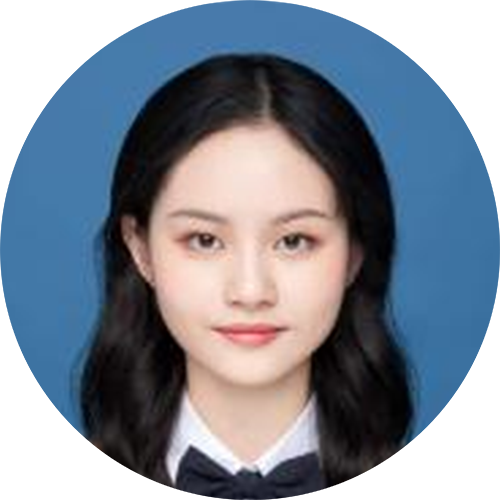Introduction
With the advancement of technologies such as 5G, big data, and artificial intelligence, educational informatization has emerged as a crucial direction for vocational education reform. National policies, including the "National Implementation Plan for Vocational Education Reform" and the "Opinions on Promoting High-Quality Development of Modern Vocational Education," both underscore the necessity for vocational education to align with technological trends (State of Council, 2019) and facilitate the deep integration of information technology with education and teaching, thereby establishing high-standard practical training bases and innovative educational models (Zhou, Fan and Zhou, 2022). This endeavor not only entails the upgrading of teaching resources and tools but also necessitates the digital transformation of educational philosophies and teaching methodologies.
Vocational education centers on practice, emphasizing the integration of skill development with the workplace environment. Traditional classroom teaching models have found it increasingly difficult to meet these demands. Information-based teaching methods leverage immersive interactive technologies to provide students with learning experiences that closely resemble real-world job scenarios, thereby facilitating the "integration of theory and practice." Exploring the application of information-based teaching in secondary vocational education holds significant importance for enhancing students' technical skills and achieving collaborative school-enterprise education. Against this backdrop, this study is dedicated to exploring virtual simulation technology solutions suitable for normalized teaching practices. Using specialized courses at a certain secondary vocational college as a practical platform, the study conducts two rounds of systematic action research to thoroughly investigate the application effects of virtual simulation technology in secondary vocational classroom instruction. The research primarily focuses on the usability, practicality, and teaching effectiveness of the technology, aiming to provide vocational colleges with replicable and scalable virtual simulation teaching practice models that promote the deep integration of information technology with vocational education.
Research Objectives
Against the backdrop of the rapid development of educational informatization and in light of the teaching demand for the "integration of theory and practice" in vocational education, systematic literature research and practical investigations have revealed that virtual simulation teaching technology significantly enhances the quality of classroom instruction. However, vocational colleges currently face prevalent practical challenges, such as inadequate training facilities and a shortage of equipment. Coupled with the inherent issues of high development costs and complex operation associated with virtual simulation technology, its effective application and widespread adoption in daily teaching have proven difficult. This practical contradiction constitutes the core issue that this study aims to address. Based on the aforementioned background, this study is dedicated to exploring virtual simulation technology solutions suitable for normalized teaching practices. Using the specialized courses of a certain secondary vocational school as a practical platform, the study conducts in-depth investigations into the application effects of virtual simulation technology in secondary vocational classroom instruction through two rounds of systematic action research. The research primarily focuses on the usability, practicality, and teaching effectiveness of the technology, with the aim of providing vocational colleges with replicable and scalable virtual simulation teaching practice models that facilitate the deep integration of information technology and vocational education. The research objectives are outlined as follows:
I) Select appropriate virtual simulation teaching technologies based on the current state of curriculum instruction and the conditions for virtual simulation teaching at Secondary Vocational School L;
II) Construct a virtual simulation teaching design model tailored to secondary vocational courses, in accordance with the typical APT teaching model, and integrate it with instructional content for teaching design purposes;
III) Implement virtual simulation teaching practices in secondary vocational classrooms, analyze existing issues, and make necessary adjustments;
IV) Investigate the instructional effects of the selected virtual simulation teaching technologies in secondary vocational classrooms and propose corresponding teaching recommendations.
Literature Review
Suggestions on the Construction of Virtual Simulation Teaching Resources
The research on virtual simulation teaching resources primarily centers on the construction of practical training bases, the enhancement of teachers' application capabilities, and the in-depth integration of technology with teaching. Scholars have highlighted that current virtual simulation practical training bases in vocational colleges face the issues of "three highs and three difficulties," necessitating optimization in terms of overall planning, institutional mechanisms, and the development of a "dual-qualified" teaching staff (Li, Li and Fang, 2023). Meanwhile, although teachers demonstrate a strong awareness of information-based teaching capabilities, they often lack technical proficiency and original school-based resources (Liang, Jiang, and Zhao, 2016). Furthermore, Luo Liping proposed the "work-integrated learning" model, advocating for collaborative development of teaching resources between schools and enterprises (Luo, 2011); Zeng Zhaoxiang et al. emphasized the importance of integrating professional clusters with industrial chains to promote the co-construction and sharing of platforms by schools and enterprises (Zeng, Liu and Li, 2022).
In summary, existing research is problem-oriented, focusing primarily on the construction of practical training bases. However, further exploration is needed regarding teachers' information-based application capabilities and the in-depth integration of virtual simulation technology with practical teaching. In the future, it is essential to strengthen school-enterprise collaboration, enhance the originality and teaching adaptability of resources, and promote the high-quality development of virtual simulation teaching.
The Value and Pathways of Virtual Simulation in Vocational Education
The research on the application value and pathways of virtual simulation technology in vocational education primarily revolves around participating entities, resource construction, and application models. Scholars have pointed out that the current informationization construction in vocational colleges places excessive emphasis on technological updates while neglecting the integration of educational theory and practice (Ren, 2015). Li Wenjing emphasizes the need to strengthen top-level design, promote collaboration among "government, vocational colleges, and enterprises," and establish a new paradigm for digital learning (Li & Wu, 2021); Peng Zihan et al. propose integrating international experiences with regional coordination to facilitate balanced resource development (Peng & Wang, 2019). In terms of application, Yang Hui et al. advocate for the systematic and intelligent design of practical training resources (Yang & Peng, 2020), while blended teaching models such as the flipped classroom are emerging as a direction for reform (Huang, 2018).
Research indicates that the effective application of virtual simulation technology relies not only on the technology itself but also necessitates policy support, innovation in educational philosophies, and the integration of practical experiences. In the future, it is essential to promote industry-education collaboration, develop scenario-based learning models that combine virtual and real-world elements, and achieve high-quality development in vocational education.
Application of VR Technology in Secondary Vocational Education
Virtual simulation technology is widely applied in vocational education and teaching, encompassing multiple fields such as simulated demonstrations in cultural courses, three-dimensional simulations of tourist attractions, medical technology training, and stereoscopic displays of engineering equipment (Wang & Li, 2011). This technology has effectively enhanced teaching efficiency and improved students' classroom engagement. Currently, the informatization of secondary vocational education primarily employs "computer screen-based virtual simulation technology," with applications predominantly concentrated in engineering disciplines such as automotive repair and computer science, while the use of virtual simulation in liberal arts courses remains relatively inadequate.
Table 1
Current Application Status of Virtual Reality Technology
in Secondary Vocational Education
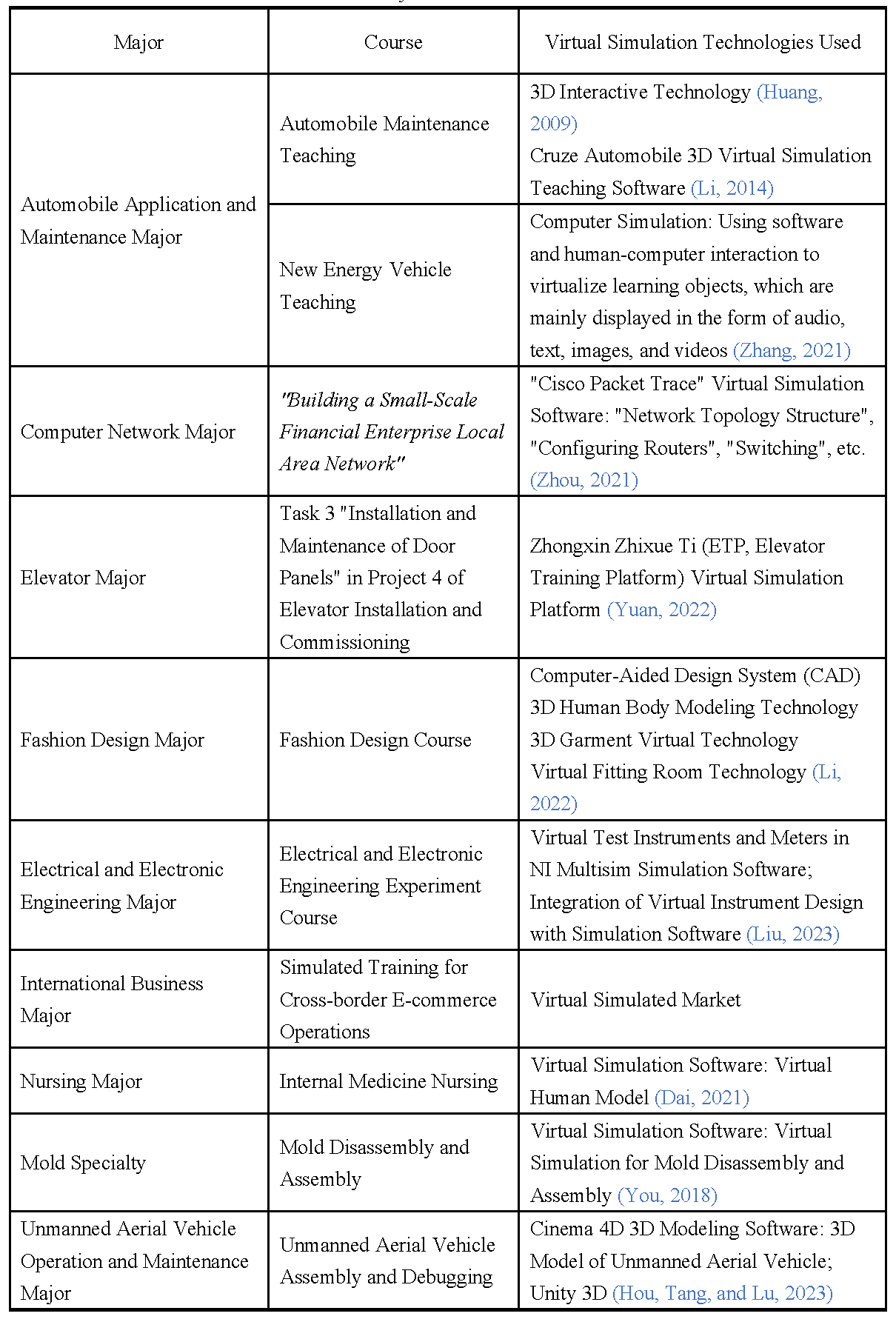
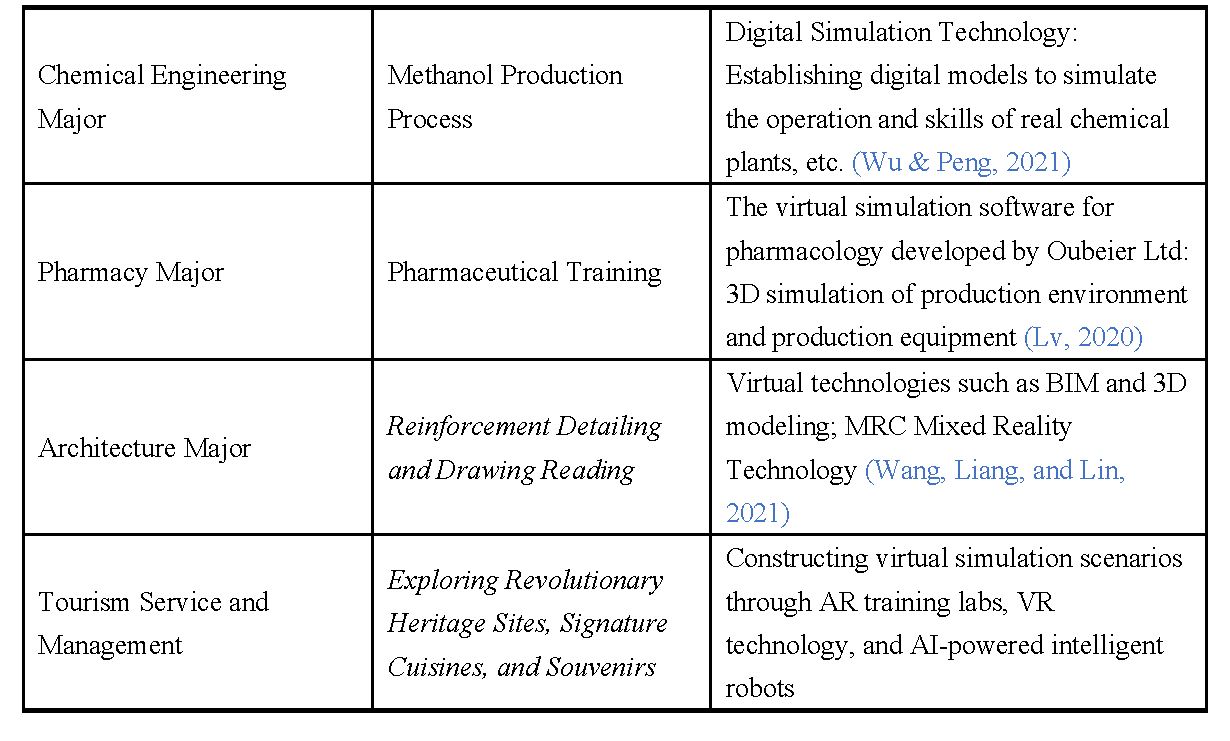
Model Construction
APT Teaching Model in the Information Environment
The APT teaching model is an instructional paradigm that underscores the integration of assessment methods, pedagogical approaches, and technological tools. With the advent of the 21st century, there has been a surge in the incorporation of information technology into classroom instruction. Fan Fulan et al. proposed an information-based teaching model within the context of information technology-enhanced education, which is assessment-led and integrates pedagogical strategies with technological tools (Wang & Li, 2021). This model is also referred to as the APT teaching model. Through empirical research, they discovered that the APT teaching model can effectively enhance students' classroom engagement and foster their autonomous learning capabilities. Within the APT teaching model, assessment methods, pedagogical approaches, and technological tools form an inseparable entity, with each component interacting and influencing the others. Assessment methods and pedagogical approaches serve as the prerequisites for determining the technological tools employed, while technological tools, in turn, provide technical support for the implementation of assessment methods and pedagogical approaches.
Based on the APT teaching model, this study constructed a three-stage teaching framework model of "investigation-design-application" by integrating virtual simulation technology, as illustrated in Figure 1. During the investigation stage, questionnaire surveys are employed to analyze students' learning conditions, encompassing their learning interests, autonomous learning awareness, and acceptance of multimedia instruction. This provides a foundation for instructional design. In the design stage, systematic planning is conducted from three dimensions: assessment methods, technological tools, and pedagogical approaches. Panoramic VR interactive courseware and Seewo Whiteboard are utilized as instructional technological tools throughout the entire classroom session. For assessment methods, a combination of teacher evaluation and student evaluation is selected. Regarding pedagogical approach selection, grounded in learners and their learning needs, instructional objectives, content, methods, and activities are meticulously designed. During the application phase, relying on information technology tools such as panoramic VR interactive courseware and Seewo Whiteboard, a six-step teaching process of "scenario introduction—new knowledge explanation—case discussion—task-driven learning—achievement presentation—summary and evaluation" is adopted. This process facilitates the transformation to a "student-centered" teaching paradigm through teaching activities including role-playing and group discussions. By systematically integrating teaching methods (such as situational teaching approach and lecture method), evaluation means, and technological tools (e.g., panoramic VR interactive courseware), this model effectively promotes students' autonomous, cooperative, and inquiry-based learning in the course of "Tea Product Marketing."
Figure 1
Virtual Simulation Instructional Design Based on the APT Teaching Model
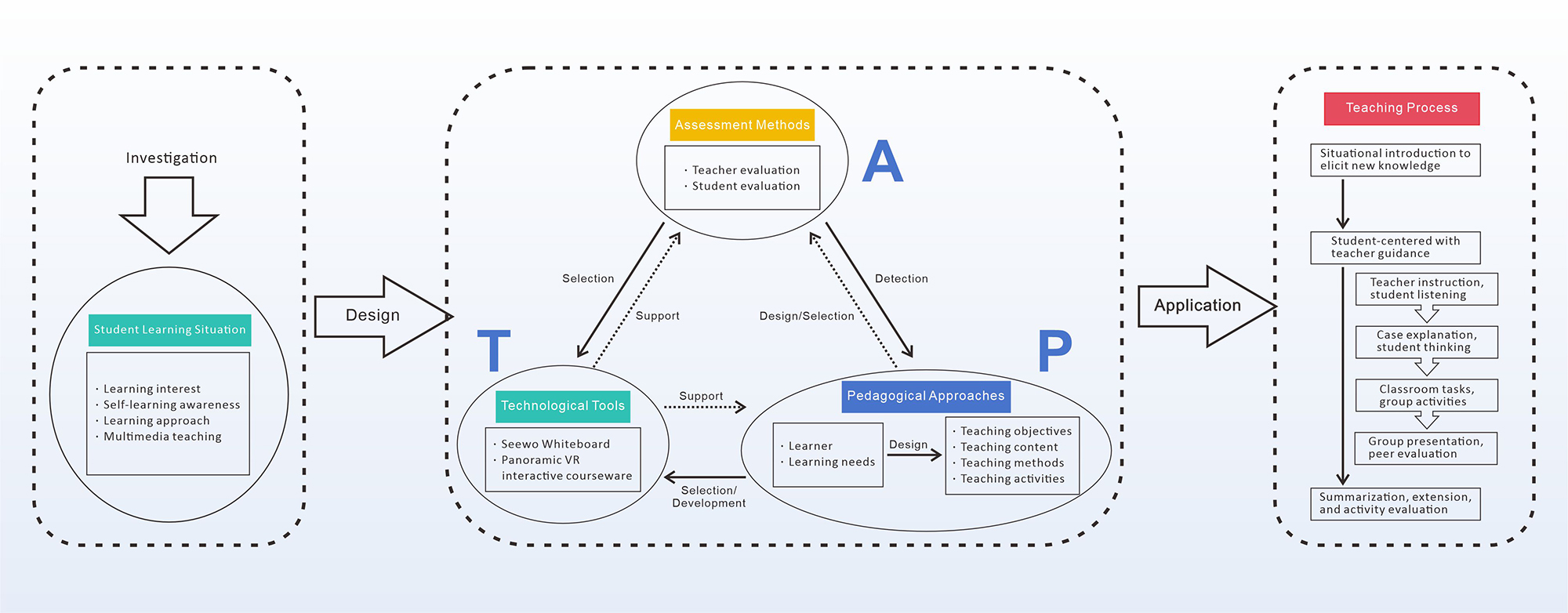
Analysis of Design Elements
Based on the established framework for virtual simulation instructional design grounded in the APT model, and taking into account the characteristics of panoramic VR interactive courseware, an analysis of the instructional design elements for panoramic VR interactive courseware is conducted. These elements are categorized into three dimensions: assessment methods, pedagogical approaches, and technological tools, as presented in Table 2.
Table 2:
Table of Instructional Design Elements for Virtual Simulation Based on the APT Model
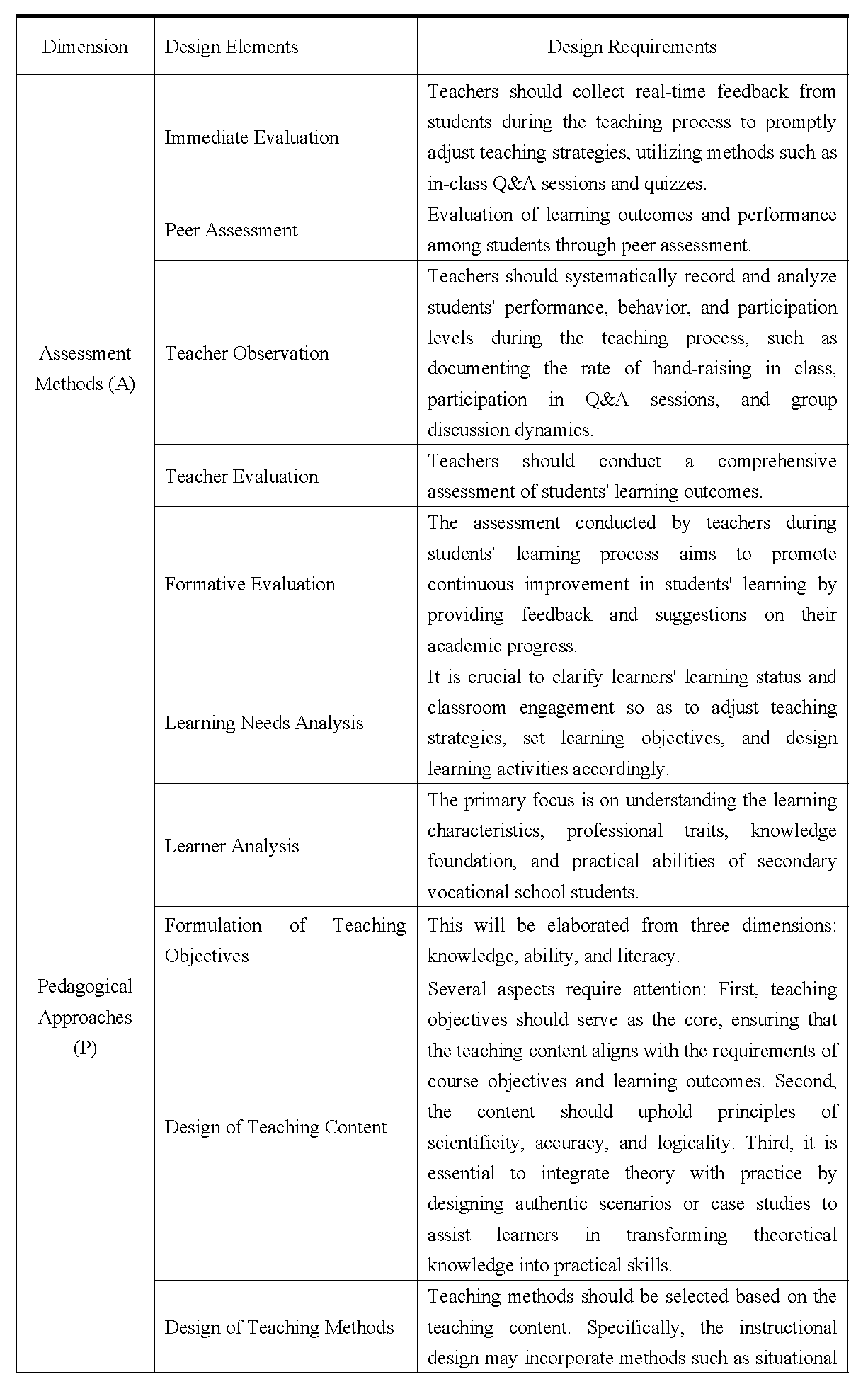
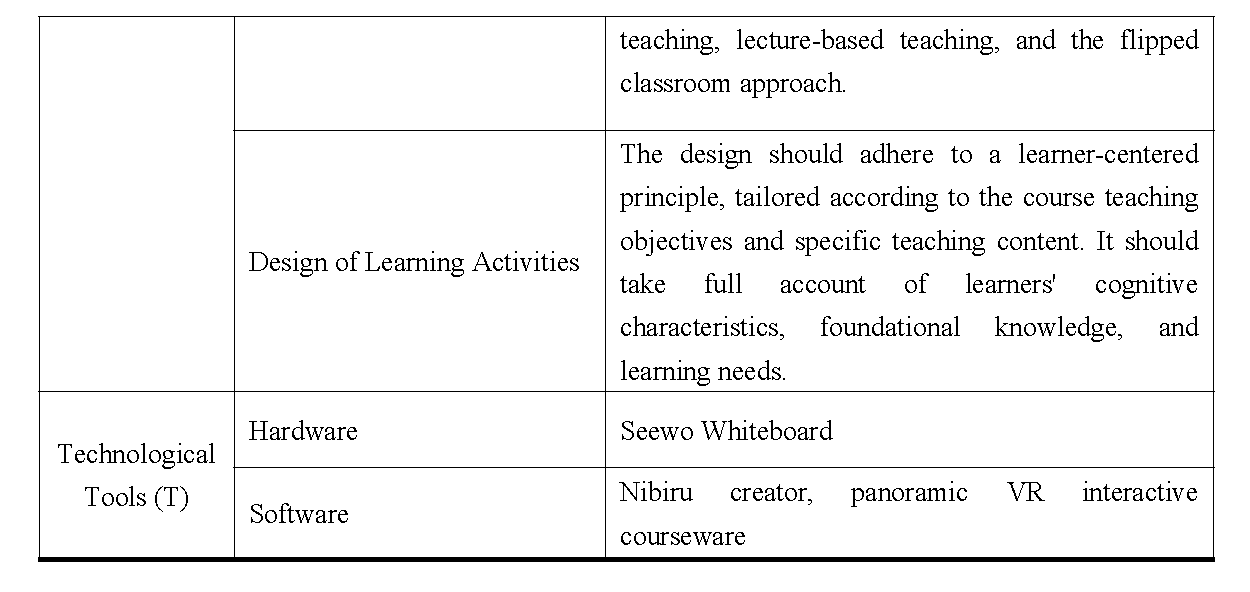
Evaluation Approaches
Teacher evaluation encompasses two dimensions: self-assessment and peer evaluation. Teacher self-assessment involves a systematic reflection on key elements such as teaching objectives, methods, and student performance. This process facilitates professional development and the optimization of teaching strategies, often allowing for real-time adjustments based on classroom observation data. Peer evaluation, on the other hand, enables the sharing of experiences and the innovation of teaching methods through observation and feedback among teachers. It offers diverse perspectives for enhancing teaching practices.
Student evaluation encompasses peer assessment, real-time evaluation, teacher evaluation, teacher observation, and formative assessment. Peer assessment is conducted through group collaboration, enabling students to enhance their collaborative and reflective abilities by providing mutual feedback. Real-time evaluation leverages classroom interactive tools to dynamically adjust teaching strategies on the fly. Teacher evaluation takes a comprehensive approach, assessing both students' mastery of knowledge and their development of abilities. Teacher observation involves recording behavioral data to support personalized instruction tailored to individual students' needs. Formative assessment, meanwhile, promotes the optimization of the learning process through periodic feedback. This evaluation system underscores the principles of diversity, dynamism, and developmental orientation, aligning with the overarching goal of "learner-centered" teaching.
Teaching Methodology
Learning Needs Analysis
The instructional design of this study primarily aims to enable students to gain a clearer understanding of the teaching content in Tea Product Marketing through panoramic VR interactive courseware, actively participate in classroom activities, and enhance their enthusiasm. The key focus lies in students learning the theoretical knowledge of the 4P marketing mix, developing a profound comprehension of the teaching content presented in case studies. The challenge, however, is for students to apply the 4P marketing mix to design group marketing plans. Teachers should pay attention to establishing a well-defined learning framework and guiding students through a transition from knowledge comprehension to practical application by designing progressive tasks. Meanwhile, students should be encouraged to engage in critical thinking and innovative practices, thereby cultivating their comprehensive abilities to solve real-world marketing problems.
Learner Analysis
This course is primarily targeted at secondary vocational school students. While they possess a certain foundation of general cultural knowledge, they still lack an in - depth understanding of the specialized knowledge and practical skills related to tea product marketing. Secondary vocational school students generally demonstrate a strong interest in practical operations and detailed case analyses. The introduction of panoramic VR interactive courseware can effectively stimulate their learning enthusiasm and enhance their level of participation. Panoramic VR interactive courseware not only offers an immersive learning experience but also creates authentic practical scenarios for students. This enables them to actively explore various aspects of tea product marketing through interaction. Such a learning approach not only aids students in better comprehending theoretical knowledge but also strengthens their adaptability to practical operations.
Through the study of this course, it is anticipated that students will acquire fundamental knowledge and pivotal skills in tea product marketing, and cultivate the ability to engage in marketing and service activities within the tea industry and related product sales sectors. The ultimate objective is to equip students with the capacity for independent thinking and problem - solving, thereby laying a solid foundation for their future career development.
Formulation of Teaching Objectives
a.Knowledge Mastery and Deepening. By utilizing panoramic VR interactive courseware, students will systematically learn the fundamental concepts, theoretical frameworks, and core elements of Tea Product Marketing, such as the ten business models of tea and their connotations, as well as the marketing approaches for gift teas. The virtual scenarios within the courseware will facilitate the integration of theoretical knowledge with practical applications for students. Through teacher-led instruction and classroom activities, students will gain an in-depth understanding of how marketing strategies are applied in real-world contexts, thereby strengthening the connection between theory and practice.
b.Skill Enhancement and Expansion. The assistance of panoramic VR interactive courseware in classroom teaching significantly helps students immerse themselves in the scenarios created by the teacher. In these settings, they can learn relevant concepts and knowledge of tea product marketing and apply what they've learned to collaborate with group members on completing in-class tasks, such as formulating marketing plans. During group collaboration, students acquire the ability to communicate effectively, divide tasks among team members, and work together to solve marketing problems, thereby enhancing their teamwork and interpersonal skills.
c.Cultivation of Literacy and Shaping of Values. The use of panoramic VR interactive courseware to assist classroom teaching serves to stimulate students' innovative thinking, encouraging them to explore new methods and approaches in marketing strategies. During classroom activities, students learn to abide by industry norms and laws and regulations, establishing correct professional ethics and contributing to upholding a positive image for the tea product marketing industry. By gaining insights into tea culture and marketing strategies, students will enhance their sense of identity and pride in Chinese tea culture, thereby promoting cultural heritage and innovation.
Design of Teaching Content
Based on the course teaching schedule and students' learning progress, the teaching content as presented in the table has been selected and will be delivered in combination with panoramic VR interactive courseware. The course materials employed for this teaching content are sourced from Tea Marketing and Marketing Chinese Tea: Understanding Tea Marketing in 2 Hours, as well as through online data collection. This section of the content aims to familiarize students with the existing sales models and relevant tea sales strategies in the current tea market. It helps students gain a comprehensive understanding of the marketing ecosystem in the tea market, master the core strategies of modern tea marketing, and lay a solid professional foundation for their future careers in the tea industry.
Table 3
Teaching Content of the Panoramic VR Interactive Courseware
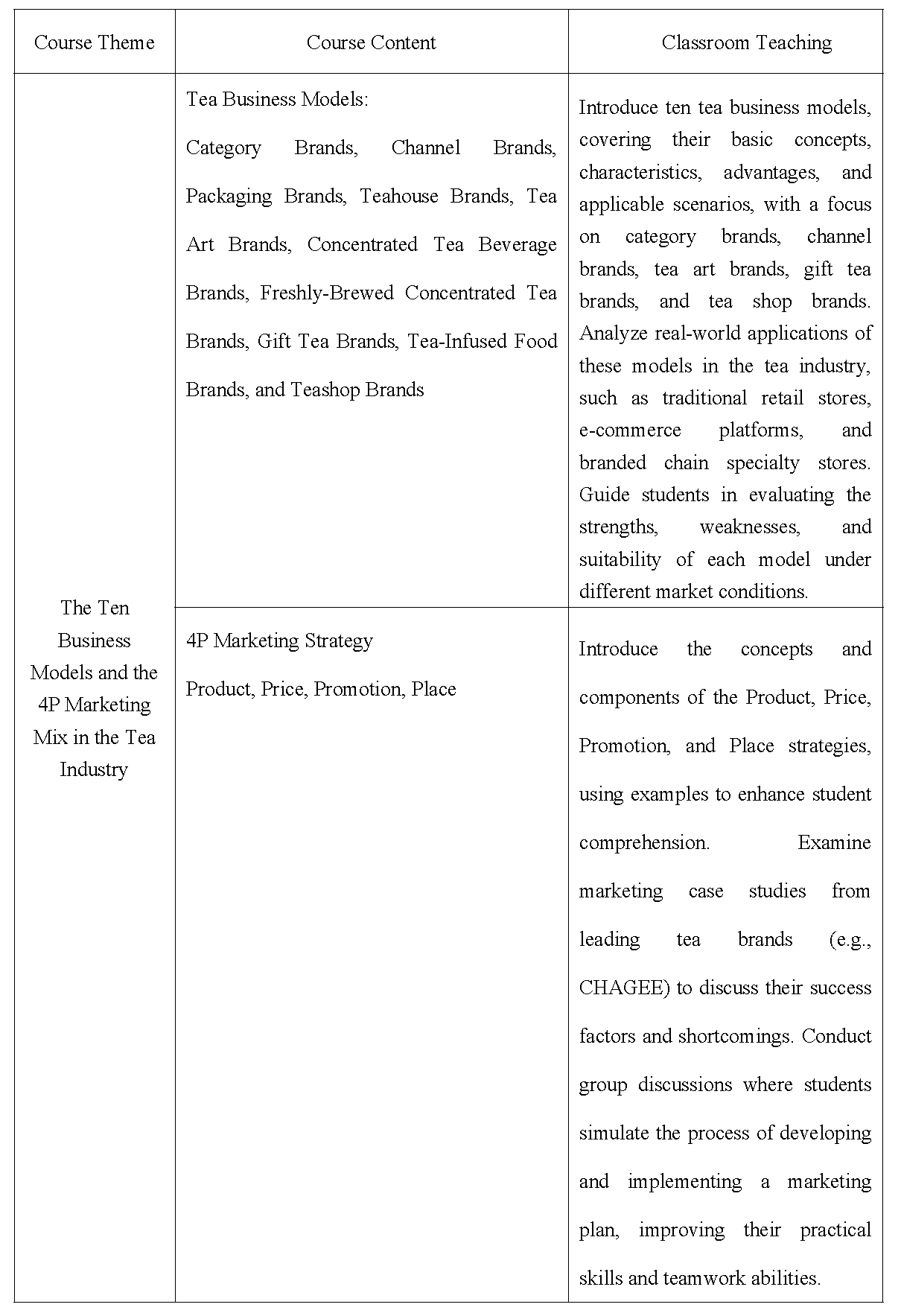
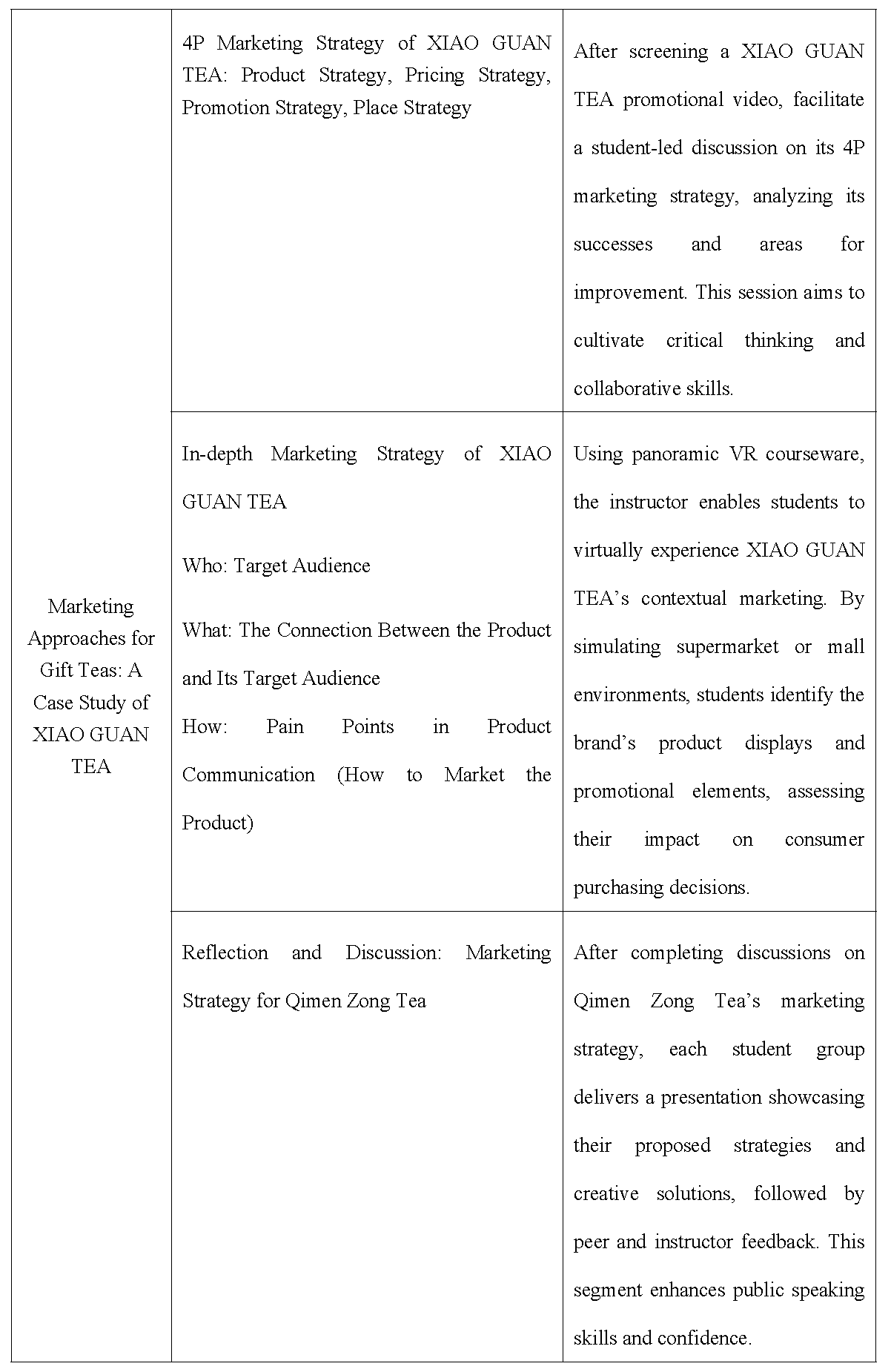
Design of Teaching Methodologies
In alignment with the teaching content, this instructional session has selected questionnaires, research-based teaching, lecture method, situational teaching, and flipped classroom as the pedagogical approaches to be employed in the classroom. The specific details of the teaching methods utilized during the class are outlined in the table below.
Table 4
Teaching Methodologies Employing Panoramic VR Interactive Courseware
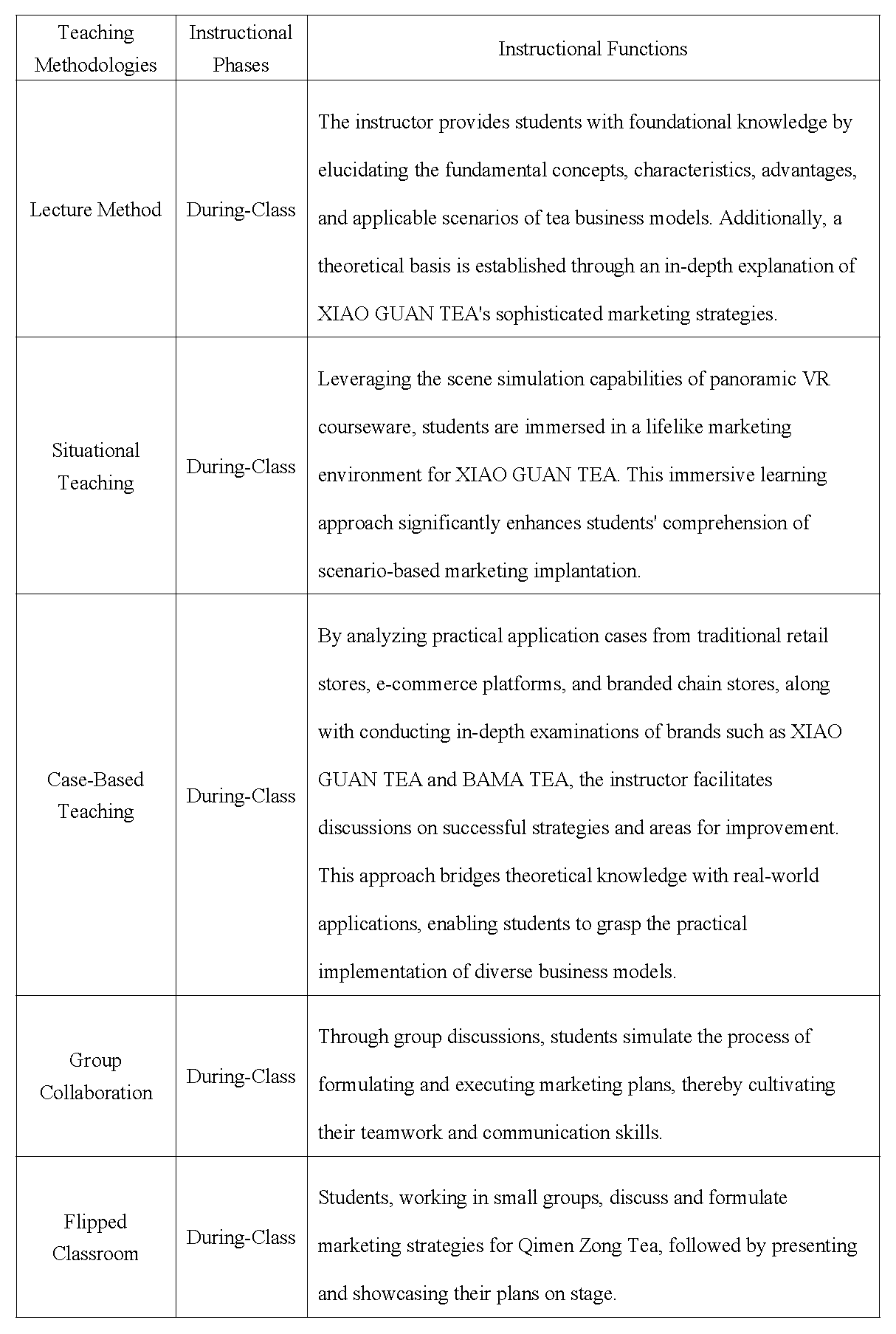
Design of Learning Activities
This instructional design incorporates two practical activity segments: "Scenario Simulation" and "Group Collaboration and Presentation." These segments are designed to assist students in consolidating their knowledge retention after learning theoretical concepts, either through teacher-posed questions or classroom activities. Moreover, they facilitate the translation of theoretical knowledge into practical application, thereby embodying a teaching approach that integrates theory with practice.
a.Scenario Simulation. In the teaching module focused on an in-depth analysis of Xiaoguantea's innovative scenario-based marketing strategies, this study fully leverages the technological advantages of panoramic VR interactive courseware to create a multi-dimensional immersive learning environment. Through virtual simulation software, instructors can seamlessly transition between various virtual scenarios, such as an "ordinary airport VIP lounge" and a "teahouse-style airport VIP lounge," guiding students to deeply experience the unique atmospheres of different marketing scenarios from a first-person perspective. Within the "teahouse-style VIP lounge," students assume the role of "VIP guests," allowing them to appreciate the marketing artistry in high-end social settings.
b.Group Collaboration and Presentation. During the thinking and discussion session, after students watch videos related to Qimen Zongcha, the instructor organizes them into groups to engage in collaborative discussions on marketing strategies for Qimen Zongcha. Students are required to integrate the marketing theories they have learned previously to develop practical and feasible marketing plans. Subsequently, each group presents their marketing strategies and creative proposals, receiving feedback and evaluations from both their peers and the instructor.
Technological Tools
Introduction to Technological Tools
Nibiru Creator, as an AR/VR cloud design editor, offers developers an efficient and user-friendly platform for creating AR/VR content, thanks to its rich functionality and intuitive operational interface. Widely applied across various sectors such as education, entertainment, and healthcare, Nibiru Creator provides robust technical support for the development of AR/VR content. For instance, in the educational sphere, Nibiru Creator can be utilized to construct virtual laboratories and virtual classrooms, offering students a more intuitive and engaging learning experience.
Figure 2
Homepage of the Official Nibiru Creator Website
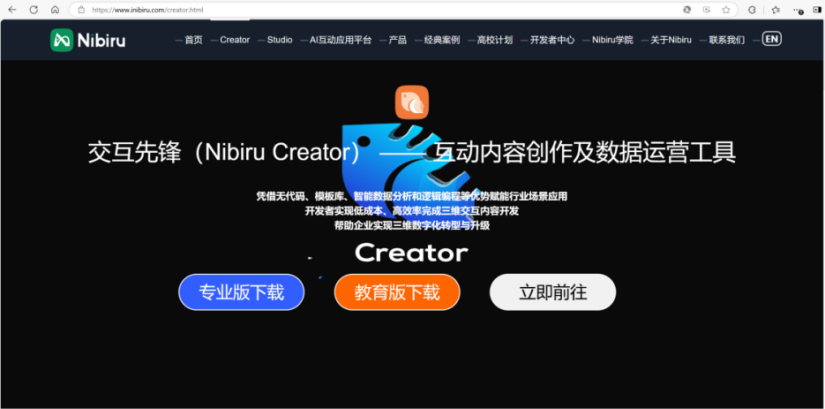
Figure 3
Operational Interface of the Nibiru Creator Software
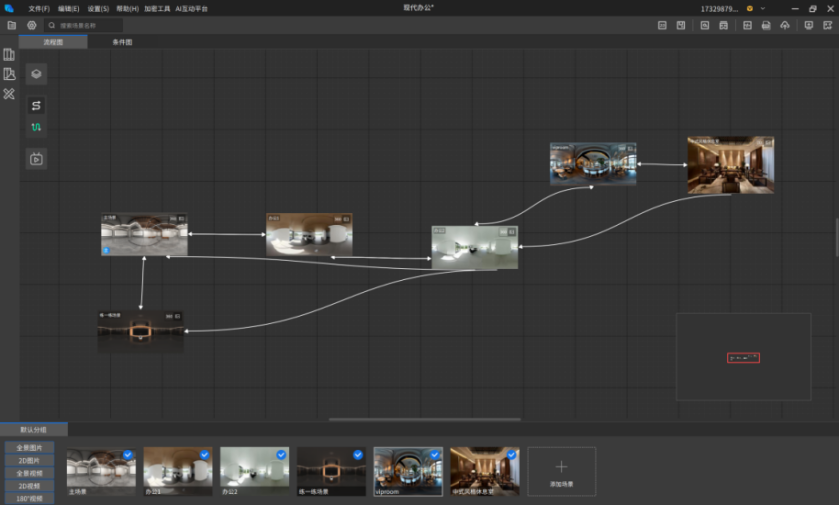
Technical Usability
a.Multi-Device Compatibility. The panoramic VR interactive courseware created using Nibiru Creator can be generated as H5 interactive courseware, namely, web-based courseware. This type of courseware is not restricted by device limitations and can run smoothly in various browsers that support HTML5. Whether on computers, tablets, or smartphones, users can access and experience the courseware anytime, anywhere. This flexibility significantly enhances the convenience of learning, enabling educational resources to be disseminated and utilized more widely. Additionally, if the source file (NPT file) is exported, offline usage becomes possible. This means that users can access course content without an internet connection, making it highly suitable for environments with unstable or unavailable network connectivity. The offline mode ensures the continuity of learning, guaranteeing the sustained progression of learning activities in diverse settings such as schools, corporate training, or outdoor educational scenarios.
b.Achieving Interactive Effects. The diverse interactive effects realized through panoramic VR interaction encompass functionalities such as clicking, jumping, dragging, and text input on the screen. These interactive methods offer students an immersive learning experience, enabling them to actively engage in the learning process. For instance, students can click on different elements to acquire more information and conduct in-depth exploration, or drag objects to comprehend complex concepts and structures. This approach not only stimulates students' curiosity but also enhances their operational skills and spatial imagination. Furthermore, the interactive effects facilitate real-time feedback and communication among students in the classroom, such as through educational games, quizzes, and other classroom activities, thereby strengthening classroom interactivity. Teachers can leverage these interactive features to adjust teaching content and pace more flexibly, gaining timely insights into students' levels of understanding and areas of confusion. This instant feedback mechanism aids teachers in making corresponding adjustments during instruction to better cater to students' learning needs.
c.Achieving Panoramic Effects. Unlike conventional courseware, panoramic VR interactive courseware boasts a unique advantage by enabling a 720-degree rotational view of the courseware screen, a feature that offers users an immersive learning experience. In traditional courseware, the viewpoint is typically fixed, restricting students to observing content from a specific position and lacking flexibility and interactivity. In contrast, panoramic VR interactive courseware allows users to freely explore content in any direction through operations such as mouse or touchscreen swiping, creating the sensation of being immersed in a genuine three-dimensional environment.
In addition, real-world images captured through photography can be transformed into panoramic visuals and subsequently developed into panoramic VR interactive courseware. Within these courseware materials, users have the freedom to insert plugins, enabling them to access related content or switch scenes with a simple click. This technology is particularly well-suited for vocational training, especially in secondary vocational education, where it can offer students in fields such as hotel management and tourism management a virtual, immersive vocational training experience. For instance, students can simulate tasks like making hotel room reservations, delivering museum commentaries, or conducting scenic spot tours. Through such immersive practices, students can acquire authentic vocational skills training, which is instrumental in enhancing their practical abilities and professional qualities.
Teaching Implementation and Application
Action Research Plan
The study was conducted in a naturally formed class of 40 students from the Tea Art and Tea Marketing program at School L in Guangzhou. It integrated panoramic VR interactive courseware into teaching with the aim of enhancing students' classroom engagement and improving teaching effectiveness.
This action research will be conducted in two rounds. Prior to the first round, a questionnaire and interview survey will be carried out to investigate the current state of virtual simulation teaching at the school and for the specific course in question. Additionally, a pre-test questionnaire will be distributed to the students in the target class before the first round of action research to gain insights into their daily learning conditions. After the conclusion of the first round, adjustments and modifications will be made to the instructional design based on the identified issues, as well as feedback and suggestions from other teachers. Subsequently, the second round of action research will be implemented. Following the completion of the second round, a post-test questionnaire will be administered to the students. An objective and comprehensive evaluation of the teaching effectiveness of the panoramic VR interactive courseware will then be conducted, taking into account peer evaluations, classroom observations, and teacher reflection records. The specific action research plan is presented in the table below.
Table 5
Teaching Action Research Plan
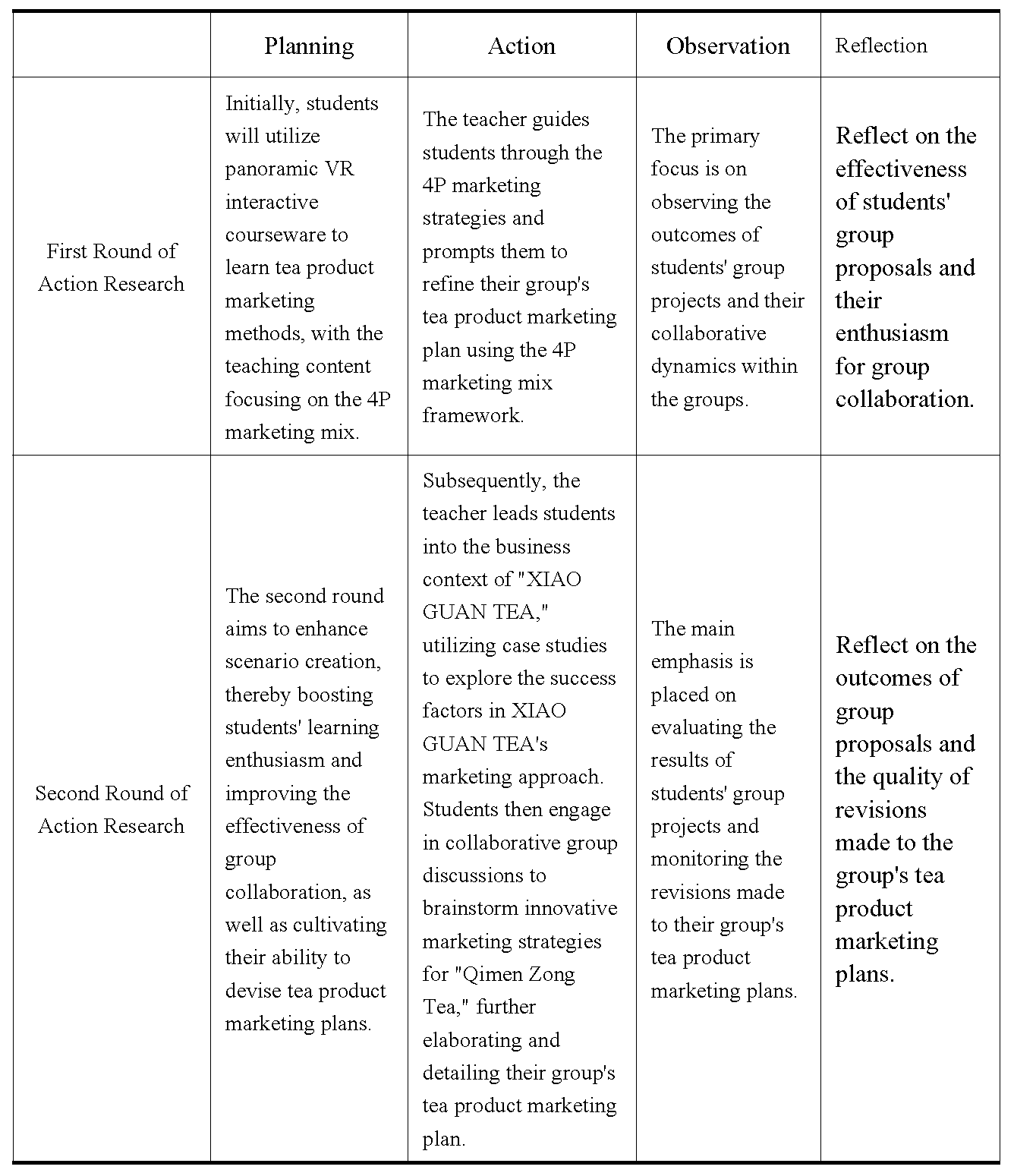
Process of Action Research
First Round of Action Research
The primary objective of the first round of action research is to assist students in mastering the business models and marketing strategies within the tea industry, while cultivating their market analysis and practical application capabilities. The instructor employs panoramic VR interactive courseware for teaching, guiding students through the relevant knowledge by following the pedagogical sequence of "introduction to new lessons, delivery of new content, knowledge consolidation, and summarization."
Through observations of classroom teaching dynamics and feedback from both teachers and students, this study has identified the following issues: The introduction of panoramic VR interactive courseware has indeed brought novelty to the teaching process; however, there exists a gap between its actual application effects and the anticipated outcomes. Given the characteristic of weak academic foundations among secondary vocational school students, teaching approaches need to be more meticulous, with content that is straightforward and easily comprehensible. Additionally, students should be granted more time for independent exploration to facilitate their understanding and mastery, thereby aligning with the practical needs of secondary vocational students. Moreover, student activities can be integrated with the panoramic VR interactive courseware to design more interactive teaching segments.
Second Round of Action Research
The primary objective of the second round of action research is to facilitate students' in-depth understanding of XIAO GUAN TEA's marketing strategies, including its underlying tactics, and enable them to develop innovative marketing plans through group collaboration. Furthermore, this round aims to cultivate students' innovative thinking and problem-solving abilities, empowering them to generate novel marketing ideas and solutions.
In this round of action research, students demonstrated notably better performance and enthusiasm in class compared to the first round, with specifics as follows: The proportion of theoretical knowledge within the teaching content was relatively reduced from that of the first round; the instructional material was presented in greater detail, with an in-depth exploration of a particular teaching case; the teaching process flowed more smoothly, with a well-balanced arrangement of content delivery and activity segments; less time was devoted to lecturing on theoretical knowledge, allowing more time for students' independent exploration; the effectiveness of interactive sessions was enhanced, leading to increased student engagement and a higher willingness to participate in answering questions.
VI.Research Findings
To evaluate the implementation effectiveness of the panoramic VR interactive courseware, this study designed 25 questions focusing on two dimensions: learning interest and learning engagement. Following the two rounds of action research, students' learning changes were measured and analyzed, with a subsequent scientific assessment of the measurement results. The survey was conducted among students from Class 2206 of the Tea Art and Tea Culture major at Guangzhou L School. In both the initial and follow-up surveys, 40 questionnaires were distributed, with all 40 being returned and deemed valid, achieving a 100% response rate. The collected data were entered and analyzed using SPSS 27 software.
Table 6
Paired-Samples t-Test Results for Pre-test and Post-test Overall Performance
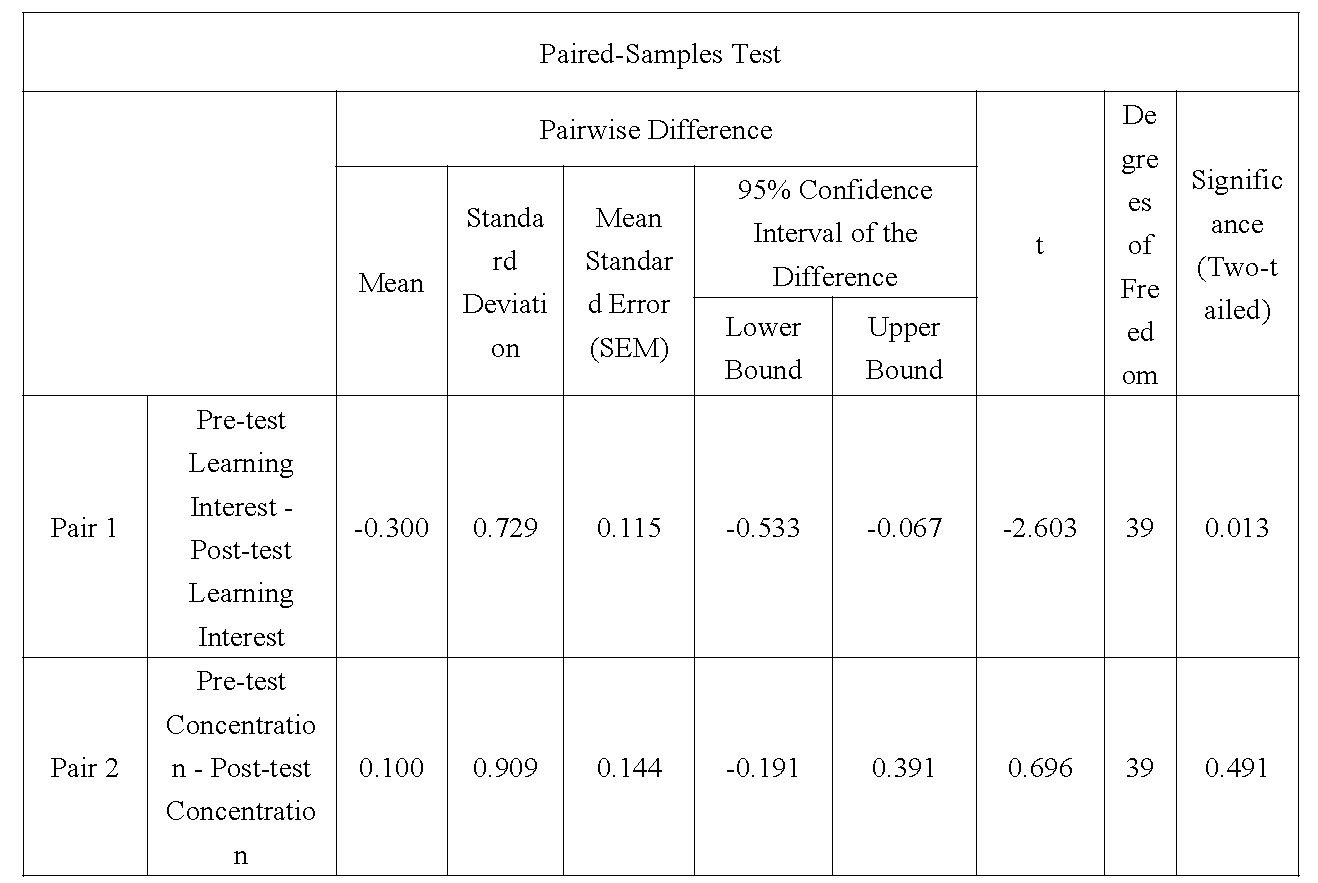
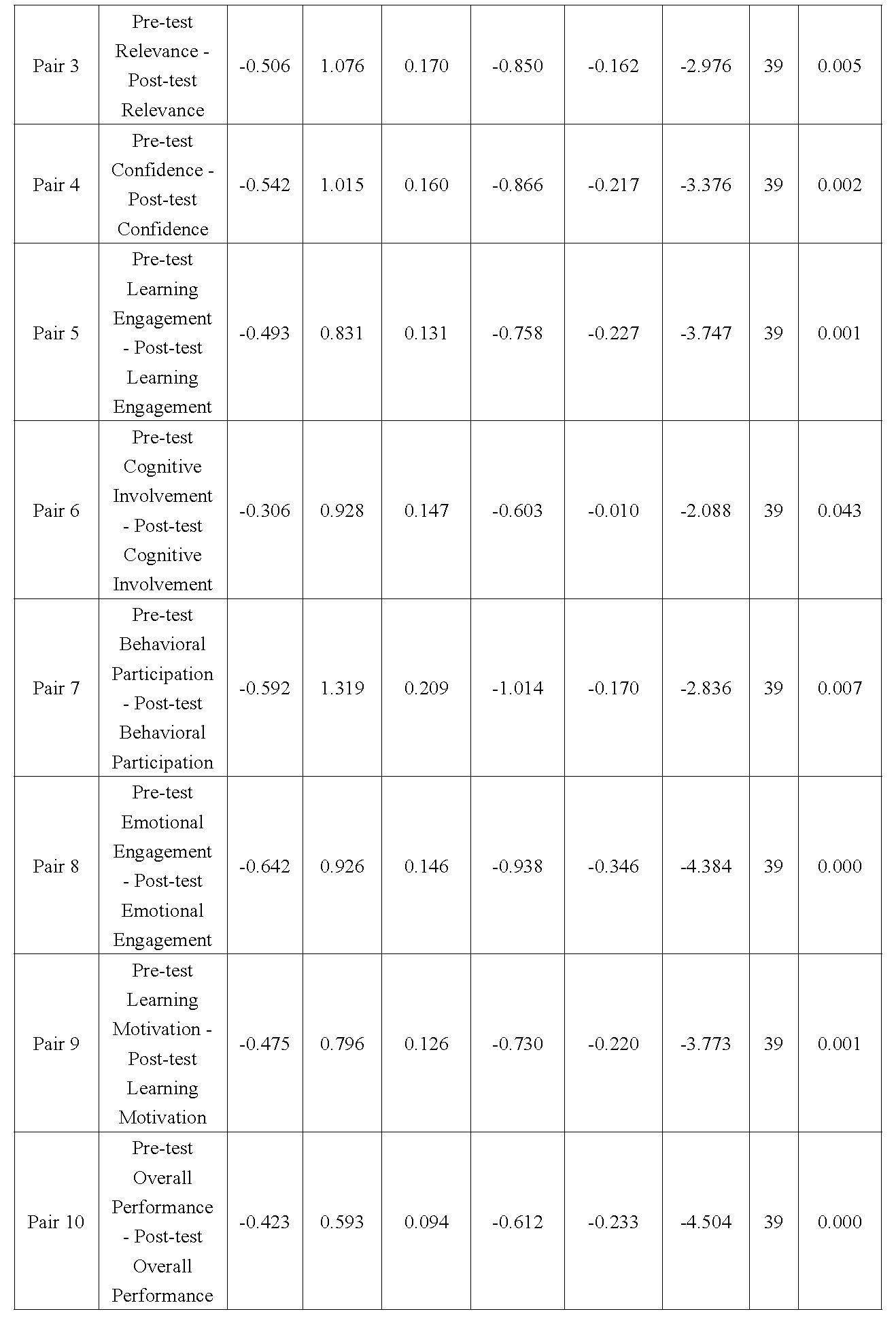
Analysis of the Learning Interest Dimension
As indicated by the table, the significance value for the pre-test and post-test of learning interest is 0.013, suggesting that the use of panoramic VR interactive courseware in teaching has a certain positive impact on enhancing students' classroom enthusiasm. From a sub-dimensional perspective, the significance values for relevance and confidence are 0.005 and 0.002, respectively, while the significance value for concentration is 0.491. These findings demonstrate that the panoramic VR interactive courseware, based on the APT teaching model, can effectively attract students' attention to a certain extent during the teaching process, stimulate their learning curiosity, and enhance their eagerness to explore and engage with the course content. Additionally, it provides timely learning feedback to students, thereby contributing to the improvement of learning outcomes.
However, with regard to the concentration dimension, the significance value stands at 0.491, failing to reach a statistically significant level. This indicates that there remains substantial room for improvement in students' levels of concentration in the classroom. Potential influencing factors may encompass the format of classroom activities designed by teachers, the practicality of the course content, as well as individual differences among students. The specific reasons affecting learning concentration are outlined as follows:
1.Content Adaptability: The course content focuses on tea product marketing, which leans more heavily towards theoretical knowledge transmission. The practical components are relatively scarce and monotonous, primarily consisting of case studies, with insufficient opportunities for students to experience the panoramic VR interactive courseware firsthand.
2.Classroom Activity Formats: In this instructional design, classroom activities mainly involve answering questions and group collaboration, lacking a diverse range of teaching activities. Further exploration is needed on how to leverage panoramic VR interactive courseware to design richer and more engaging classroom activities, thereby enhancing students' learning concentration.
3.Individual Student Differences: Some students lack prior background knowledge in marketing and show limited interest in learning about tea product marketing, leading to a decline in their classroom comprehension.
In response to the aforementioned issues, future teaching practices can be improved from the following aspects: Firstly, teachers can further optimize classroom activity designs, such as incorporating more interactive tasks or gamified elements, to enhance students' sense of participation and concentration. Secondly, panoramic VR interactive courseware should be more extensively applied in practical classroom sessions, enabling students to deepen their understanding and application of knowledge through immersive experiences. Finally, teachers can flexibly adjust teaching strategies based on students' learning characteristics, such as adopting differentiated instruction or personalized guidance, to meet the diverse learning needs of different students.
Analysis of the Learning Engagement Dimension
In terms of learning engagement, the significance values for cognitive engagement, behavioral engagement, and emotional engagement are 0.054, 0, and 0.001, respectively. These data indicate that the use of panoramic VR interactive courseware in the classroom teaching of the secondary vocational course Tea Product Marketing facilitates students' more active participation in classroom activities and encourages deeper thinking. Compared to previous learning approaches, students demonstrate stronger self-directed learning abilities in the classroom, actively engaging in activities and successfully completing assigned tasks. Additionally, there is a noticeable increase in the frequency of interactions between students and teachers, as well as enhanced collaborative exchanges among peers, which further promotes the depth and breadth of learning.
Analysis of the Learning Motivation Dimension
From the results, the significance value of the pre-test and post-test on learning motivation is 0.001, indicating that the use of panoramic VR interactive courseware in teaching yields superior outcomes compared to traditional multimedia instruction. This approach not only stimulates students' learning interest and intrinsic motivation but also provides a more intuitive and vivid learning experience, thereby enhancing their comprehension and mastery of course knowledge.
Teaching Reflection and Recommendations
Following two rounds of action research, and incorporating the results of data analysis as well as interviews with both students and teachers, the following recommendations are proposed for the instructional implementation of panoramic VR interactive courseware.
1.Showcase the Diverse Functions of the Software to Enhance the Integration of Teaching and VR. Building upon the development of additional functionalities within the software, it is crucial to further explore and experiment with demonstrating these new features in the classroom. This approach serves to enrich teaching content and improve the degree of integration between panoramic VR interactive courseware and the curriculum. By judiciously utilizing the software's capabilities, teachers can create a more vivid and interactive learning environment, enabling students to gain a more comprehensive understanding and mastery of classroom knowledge. Furthermore, introducing new functionalities during classroom demonstrations can stimulate students' curiosity and encourage their active participation in the learning process, thereby facilitating more efficient knowledge transfer and skill development. Examples of such functionalities include the software's quiz feature, the ability to create micro-lessons and animations, among others.
Currently, the panoramic VR interactive courseware is equipped with an in-class quiz feature. Although this function was not fully utilized in the present study, it is recommended that teachers incorporate it to a reasonable extent during regular teaching processes to enhance student learning feedback and interaction. For instance, after explaining each knowledge point, a short quiz can be administered to help students reinforce what they have learned while simultaneously providing teachers with an effective tool to assess students' comprehension levels. Through this approach, teachers can promptly gain insights into students' learning progress and make corresponding instructional adjustments accordingly.
In addition, by leveraging the micro-lesson and animation capabilities of the panoramic VR software, teachers can create concise and impactful instructional videos to serve as materials for pre-class preview or post-class review. These micro-lessons can assist students in swiftly grasping the key points and challenging concepts of the course, thereby stimulating their interest in learning. Moreover, animation production can be employed to visually illustrate complex theories or processes, further enhancing students' comprehension and retention. For example, teachers could develop a series of micro-lesson videos covering the main knowledge points of the course, allowing students to utilize them for pre-class preview or post-class review purposes.
2.Streamline Classroom Teaching Content and Refine Explanations of Details. Through the practice of two rounds of teaching action research in secondary vocational classrooms, it has been observed that the content of each lesson should not be overly complex. A rapid teaching pace often prevents students from effectively absorbing the presented knowledge, resulting in a superficial and cursory experience with the panoramic VR interactive courseware. Therefore, it is crucial to streamline teaching content and systematically break down and explain key knowledge points. Simultaneously, moderately slowing down the teaching pace and incorporating a variety of classroom activities can enhance the instructional effectiveness of the panoramic VR interactive courseware, maximizing its potential. This approach not only helps students better absorb and understand knowledge points but also promotes their active participation and deep thinking, thereby improving overall learning outcomes and the depth of knowledge mastery.
Building on this foundation, a phased approach to instructional design can be adopted, where panoramic VR interactive courseware is selectively developed based on the content of each class session. By focusing on explaining a specific scenario or knowledge point in each lesson, this method not only alleviates the workload for teachers but also enables students to gain an in-depth understanding of a particular subject matter during each class. Such a design aligns with the rhythm of modern classrooms and facilitates the gradual construction of students' knowledge systems through each learning experience. For instance, a teacher could concentrate on a specific experiment or operation in a single class session, ensuring that students fully comprehend and master the relevant content.
3.Prioritize Practice over Explanation and Allow Students Freedom to Explore. Based on the interview results with both teachers and students, granting students more time for independent exploration proves more effective in secondary vocational classrooms. Traditionally, excessive theoretical explanations by teachers tend to induce boredom among students, thereby dampening their willingness to actively comprehend and learn classroom knowledge. Conversely, providing students with ample time for mutual communication and free exploration not only effectively enhances their learning interest but also improves their concentration. By encouraging students to actively participate in the learning process through interactive discussions with peers, they can deepen their understanding of knowledge through practical application. Meanwhile, a free exploration environment stimulates students' curiosity, prompting them to autonomously seek solutions to problems. Therefore, throughout the entire process of utilizing panoramic VR interactive courseware to support teaching, it is not necessary to rely solely on this technology. Instead, the optimal approach combines teacher instruction, panoramic VR interactive courseware-assisted classroom interactions, and students' independent exploration.
4.Expand the Application of Panoramic VR Courseware and Innovate through Interdisciplinary Teaching Practices. As an innovative teaching tool, panoramic VR interactive courseware boasts broad applicability, spanning nearly all professional domains. However, notable differences exist among various disciplines in terms of teaching content and usage requirements, necessitating careful consideration of each field's distinctive characteristics and practical needs during the courseware development process for customized design. For instance, in medical education, VR technology can be employed to highly replicate surgical scenarios, enabling students to master surgical procedures and operational skills through immersive experiences. In engineering education, virtual laboratories can be constructed to simulate the operational principles and maintenance procedures of mechanical equipment, thereby facilitating students' in-depth understanding of complex engineering concepts.
Additionally, in the realm of liberal arts, such as history education, VR courseware can recreate historical scenes, enabling students to immerse themselves and vividly experience historical events. In art education, VR technology can offer students a virtual creative space, stimulating artistic inspiration. Although the difficulty of courseware development varies across different disciplines, teachers can flexibly utilize VR technology according to the characteristics of each course and gradually explore its application potential in various fields. Through continuous experimentation and refinement, panoramic VR interactive courseware holds promise as a versatile tool for interdisciplinary teaching, providing students from diverse majors with a richer and more intuitive learning experience.
In the context of interdisciplinary teaching practices, panoramic VR interactive courseware can be employed to design virtual historical or art museums, facilitating explanatory and hands - on training in the classroom teaching of tourism management majors. By constructing realistic virtual scenarios of historical and art museums, it becomes possible to effectively integrate the knowledge systems of multiple disciplines, including history, art, museology, and tourism management. This approach achieves cross - disciplinary teaching integration and provides students with rich and engaging learning materials.
Conclusion and Prospects
Research Conclusions
This study developed panoramic VR interactive courseware and integrated it with the course content. Based on the APT teaching model, a rigorous instructional design was formulated. The study demonstrated the effectiveness of panoramic VR interactive courseware in enhancing students' learning interest and classroom participation in the "Tea Product Marketing" course, offering valuable insights and recommendations for the future use of panoramic VR interactive courseware in teaching. The following research summary is drawn from the teaching practice and instructional outcomes of this study:
Firstly, a virtual simulation teaching model based on the archetypal APT (Assessment, Pedagogy, and Technology) framework was constructed. The key components of this model encompass assessment methods (A), pedagogical approaches (P), and technological tools (T). Utilizing this model, an instructional design for panoramic VR interactive courseware was developed, wherein teachers select diverse pedagogical strategies tailored to the course content and nature. Within the information technology environment facilitated by the panoramic VR interactive courseware in this study, various assessment methods such as real-time evaluation and peer assessment, along with pedagogical approaches including situated learning, case-based teaching, and flipped classroom, were employed.
Secondly, in accordance with the APT virtual simulation teaching model, we utilized Nibiru Creator software and its associated functionalities to design and implement an instructional plan for panoramic VR interactive courseware. Based on this foundation, two rounds of action research were conducted. During the implementation process, a comprehensive analysis of data and interview results revealed that the panoramic VR interactive courseware had a positive impact on enhancing students' learning interest, participation, and motivation. Specifically, when engaging in learning activities with the panoramic VR interactive courseware, students were more inclined to actively participate in classroom discussions and activities, demonstrating an increased level of engagement with the course content. Compared to traditional media-based instruction, the use of panoramic VR interactive courseware exerted a favorable influence on students' learning states, although there remained room for improvement in terms of learning concentration. The application of this teaching approach not only deepened students' understanding of tea product marketing knowledge but also sparked their curiosity and desire to explore this field further, ultimately leading to an overall improvement in learning outcomes.
In summary, the panoramic VR interactive courseware employed in this study offers technological reference value for secondary vocational school classroom instruction. Secondary vocational teachers can draw inspiration from the instructional design presented in this research to further leverage panoramic VR interactive courseware, thereby fostering more innovative and engaging classroom experiences.
Limitations and Prospects
This study has certain limitations. Firstly, the sample selection was confined to a subset of classes from the second grade of a particular secondary vocational school, resulting in an insufficient sample size and scope, which consequently affects the generalizability of the findings. Secondly, constrained by the limited teaching time, only two rounds of action research were conducted, which failed to fully validate the pedagogical effectiveness of the optimized panoramic VR courseware. In future research, it is essential to streamline the course content and incorporate more interactive elements to enhance learning outcomes. Furthermore, the study solely focused on the school teaching context and did not comprehensively consider the multifaceted factors influencing students' learning, indicating that both the depth and breadth of the research need to be further expanded.
Future research can be improved from the following aspects: Firstly, it is essential to deepen theoretical study in virtual simulation teaching and panoramic VR technology to solidify the theoretical foundation. Secondly, expanding the sample size and research scope to encompass multiple types of schools and disciplines will enhance the generalizability of the findings. Thirdly, extending the research duration and increasing the number of action research cycles will allow for a more comprehensive observation of teaching effects. Fourthly, refining the design of questionnaires and interviews through precise question formulation will facilitate an in-depth exploration of students' learning experiences and needs, thereby providing more valuable references for educational practice.
